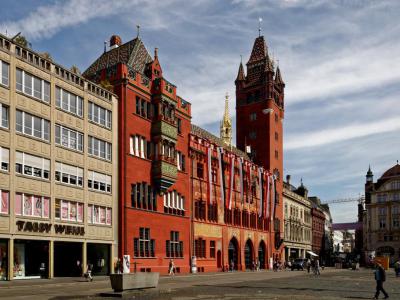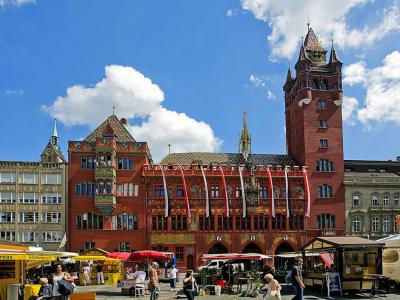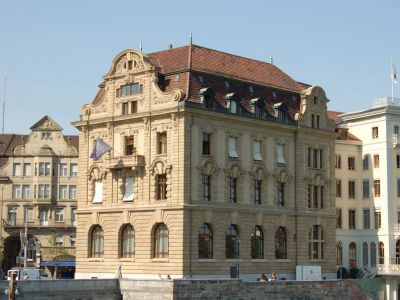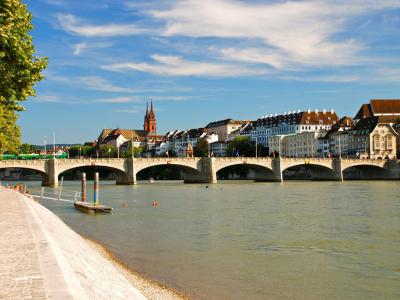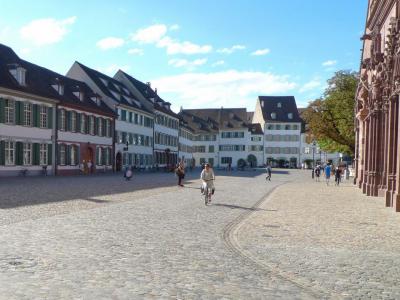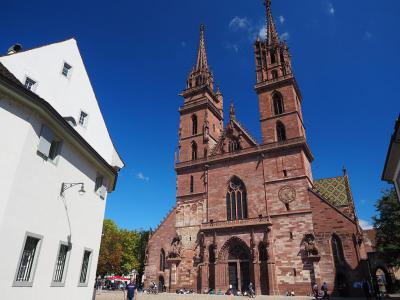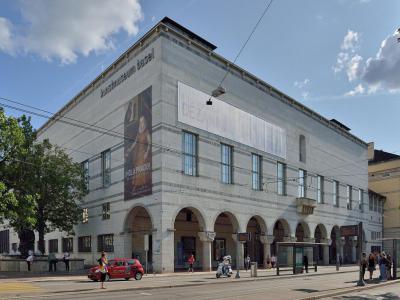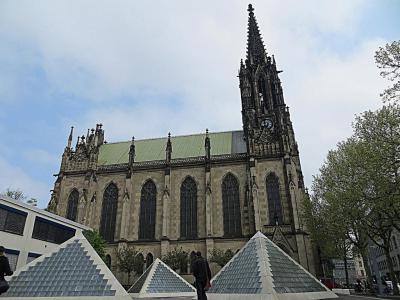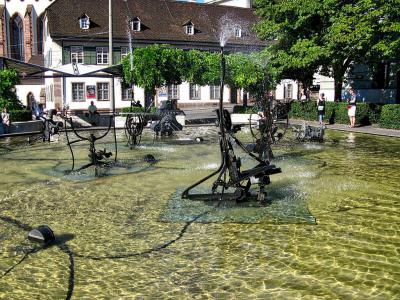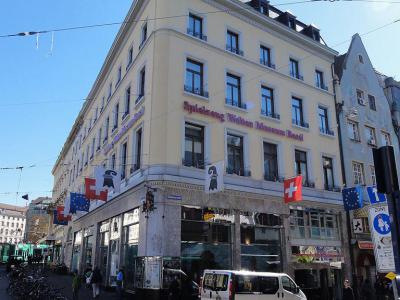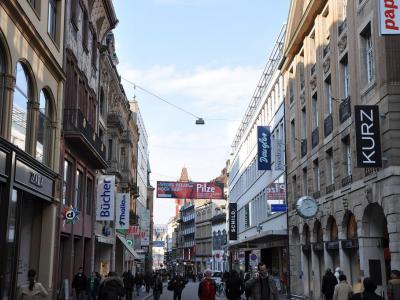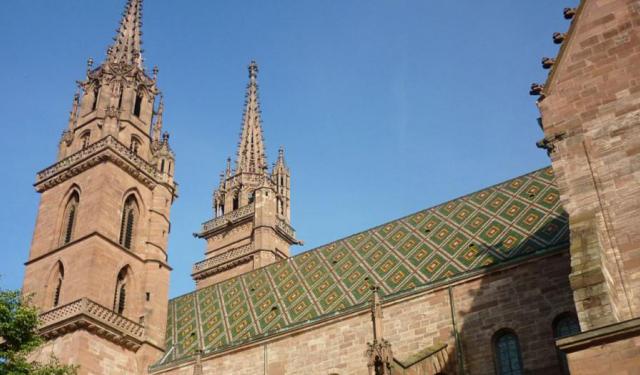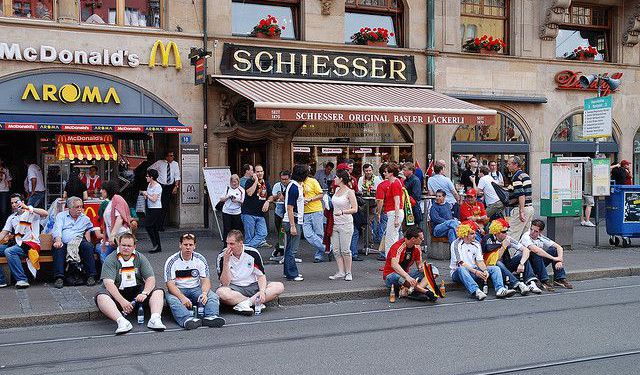
Basel Introduction Walking Tour (Self Guided), Basel
The modern and bustling city of Basel gets its name from a third-century Roman castle that stood here. It is likely the modernization of "Villa Basilius," or "Estate of Basilius." Interestingly, the basilisk has been closely associated with the city and used in the coat of arms and coins. The association is likely simple assonance rather than anything more profound.
However, it's likely that settlements here began well before the name appeared. Excavations and research have shown Gallic tribes were living here as far back as the fifth century BC. The Basel oppidum from the Iron Age sits on the site of Basel Minster.
Most of Basel that you see today was laid out during medieval times. For example, the cathedral of Basel was built between 1019 and 1500, as were many of the town squares like Market Square or Munster Square.
Basel joined the Swiss Confederacy in 1501 as the 11th canton. Thanks to a history of humanism and the local University of Basel, the city has always been known as a safe haven during times of unrest.
As with most European cities like Basel, the real draw of coming here is to appreciate the history. Among its many claims to fame, the city has been home to many notable figures such as the Bernoulli family of mathematicians, psychiatrist Carl Jung, and the site of the first World Zionist Congress.
Basel occupies a lovely spot on the river Rhine. The town is well known for the number of museums--forty of them are spread across town. It has also been ranked as one of the ten most livable cities globally, along with Zurich and Geneva.
The best way to get to know a city like Basel is to walk its streets with the locals. Visit the city's famous squares and see historic sites like the Town Hall, Middle Bridge, and the Three Kings Hotel. So, when you're ready, grab your shoes and set out on this self-guided tour of the best sights in Basel.
However, it's likely that settlements here began well before the name appeared. Excavations and research have shown Gallic tribes were living here as far back as the fifth century BC. The Basel oppidum from the Iron Age sits on the site of Basel Minster.
Most of Basel that you see today was laid out during medieval times. For example, the cathedral of Basel was built between 1019 and 1500, as were many of the town squares like Market Square or Munster Square.
Basel joined the Swiss Confederacy in 1501 as the 11th canton. Thanks to a history of humanism and the local University of Basel, the city has always been known as a safe haven during times of unrest.
As with most European cities like Basel, the real draw of coming here is to appreciate the history. Among its many claims to fame, the city has been home to many notable figures such as the Bernoulli family of mathematicians, psychiatrist Carl Jung, and the site of the first World Zionist Congress.
Basel occupies a lovely spot on the river Rhine. The town is well known for the number of museums--forty of them are spread across town. It has also been ranked as one of the ten most livable cities globally, along with Zurich and Geneva.
The best way to get to know a city like Basel is to walk its streets with the locals. Visit the city's famous squares and see historic sites like the Town Hall, Middle Bridge, and the Three Kings Hotel. So, when you're ready, grab your shoes and set out on this self-guided tour of the best sights in Basel.
How it works: Download the app "GPSmyCity: Walks in 1K+ Cities" from Apple App Store or Google Play Store to your mobile phone or tablet. The app turns your mobile device into a personal tour guide and its built-in GPS navigation functions guide you from one tour stop to next. The app works offline, so no data plan is needed when traveling abroad.
Basel Introduction Walking Tour Map
Guide Name: Basel Introduction Walking Tour
Guide Location: Switzerland » Basel (See other walking tours in Basel)
Guide Type: Self-guided Walking Tour (Sightseeing)
# of Attractions: 11
Tour Duration: 2 Hour(s)
Travel Distance: 2.3 Km or 1.4 Miles
Author: Cathy
Sight(s) Featured in This Guide:
Guide Location: Switzerland » Basel (See other walking tours in Basel)
Guide Type: Self-guided Walking Tour (Sightseeing)
# of Attractions: 11
Tour Duration: 2 Hour(s)
Travel Distance: 2.3 Km or 1.4 Miles
Author: Cathy
Sight(s) Featured in This Guide:
- Marktplatz (Market Square)
- Rathaus (Town Hall)
- Les Trois Rois Hotel (Three Kings Hotel)
- Middle Bridge
- Müensterplatz (Munster Square)
- Basel Münster (Basel Minster)
- Kunstmuseum Basel (Fine Arts Museum)
- Elisabethenkirche (St. Elisabeth Church)
- Tinguely Brunnen Fountain
- Spielzeug Welten Museum Basel
- Freie Strasse (Freie Street)
1) Marktplatz (Market Square)
The vibrant red town hall dominates Market Square. Market Square hosts a daily market that features local produce and regional and Swiss specialties. In addition, visitors can stock up on flowers, coffee, honey, crafts, and wine.
The square dates back to at least the year 1091. Back then, the square was bisected by Birsig Creek. There was a grain market where the citizens met and handled business. In 1290, the first town hall was built and that became the center of the town's political life.
In addition to the town hall, the square was home to the court. In front of the courthouse was a flat stone used for executions and public announcements. The accused often were brought here to face the ridicule of the population.
In the early days, the square was surrounded by wooden shops and houses with fold-down shutters. Through the open windows, owners would sell their goods that included meats, sausages, tripe, herring, birds, and gingerbread.
The houses were destroyed in 1891 to expand Market Square. Over the years, large commercial buildings have taken over. The square was further modified in 1908 when it was leveled out. Today, it is one of the most important tram junctions in the city, with seven lines passing through this one spot.
Market Square is delightful over the Christmas holidays. Visitors can do holiday shopping while enjoying hot chocolate and festive holiday lights. But any time of year is a great time to visit, thanks to the many charming cafes, restaurants, shops, and boutiques.
The square dates back to at least the year 1091. Back then, the square was bisected by Birsig Creek. There was a grain market where the citizens met and handled business. In 1290, the first town hall was built and that became the center of the town's political life.
In addition to the town hall, the square was home to the court. In front of the courthouse was a flat stone used for executions and public announcements. The accused often were brought here to face the ridicule of the population.
In the early days, the square was surrounded by wooden shops and houses with fold-down shutters. Through the open windows, owners would sell their goods that included meats, sausages, tripe, herring, birds, and gingerbread.
The houses were destroyed in 1891 to expand Market Square. Over the years, large commercial buildings have taken over. The square was further modified in 1908 when it was leveled out. Today, it is one of the most important tram junctions in the city, with seven lines passing through this one spot.
Market Square is delightful over the Christmas holidays. Visitors can do holiday shopping while enjoying hot chocolate and festive holiday lights. But any time of year is a great time to visit, thanks to the many charming cafes, restaurants, shops, and boutiques.
2) Rathaus (Town Hall) (must see)
Town Hall is home to the Basel government and parliament. This dramatic red brick building with its imposing tower is one of Basel's most attractive landmarks.
The current Town Hall was built between 1504 and 1513 to celebrate Basel's joining the Swiss Confederation. It replaced an older, less grand structure. While the building has undergone many renovations over the centuries, the three iconic arched entrances are from the initial construction.
Artist Hans Holbein decorated the Town Hall's Assembly Hall in 1521. Hans Holbein would later rise to fame as King Henry VIII's court painter.
The Gothic-style Front Chambers were added in the 1600s. The tower was added in the 1800s. At the time, its imposing height was controversial, and a public vote was called before construction was approved.
The exterior facade features depictions of historical and legendary figures. On the balcony, an inscription reminds visitors Here begins Swiss land. The crenellations are decorated with Basel's coats of arms.
The interior is richly decorated. The courtyard features a Roman statue representing Julius Caesar's contemporary Lucius Munatuis Plancus. Plancus founded Augusta Raurica, the nearby Roman city.
Many paintings depict a law and order theme. For example, the Roman goddess of Justice, Justitia, is depicted in a scene over the Front Chambers.
The Cantonal Parliament debates twice a month in the assembly hall. The Cantonal Government meets in Town Hall every Tuesday. The Chancellery and the Department of Presidental Affairs are also located in the Town Hall.
Guided tours in English are available every Saturday at 4:30 p.m.
The current Town Hall was built between 1504 and 1513 to celebrate Basel's joining the Swiss Confederation. It replaced an older, less grand structure. While the building has undergone many renovations over the centuries, the three iconic arched entrances are from the initial construction.
Artist Hans Holbein decorated the Town Hall's Assembly Hall in 1521. Hans Holbein would later rise to fame as King Henry VIII's court painter.
The Gothic-style Front Chambers were added in the 1600s. The tower was added in the 1800s. At the time, its imposing height was controversial, and a public vote was called before construction was approved.
The exterior facade features depictions of historical and legendary figures. On the balcony, an inscription reminds visitors Here begins Swiss land. The crenellations are decorated with Basel's coats of arms.
The interior is richly decorated. The courtyard features a Roman statue representing Julius Caesar's contemporary Lucius Munatuis Plancus. Plancus founded Augusta Raurica, the nearby Roman city.
Many paintings depict a law and order theme. For example, the Roman goddess of Justice, Justitia, is depicted in a scene over the Front Chambers.
The Cantonal Parliament debates twice a month in the assembly hall. The Cantonal Government meets in Town Hall every Tuesday. The Chancellery and the Department of Presidental Affairs are also located in the Town Hall.
Guided tours in English are available every Saturday at 4:30 p.m.
3) Les Trois Rois Hotel (Three Kings Hotel)
The Three Kings Hotel is one of Switzerland's oldest hotels and has welcomed visitors and merchants since the 13th century. In the middle age, the hotel was a popular place to stay among salt traders due to its location right next to the salt tower where ships were docked in order to transport the sought-after commodity down the Rhine River and out into the rest of Europe.
The current luxurious hotel was originally built in 1844. Johann Jakob Senn was a master tailor who foresaw that the railway and river steamer revolution would expand leisure travel and gambled on building this luxury hotel. Basel architect Amadeus Merian designed the Belle Epoque-style hotel.
Many grand hotels are named after the Biblical "Three Kings," who brought gifts to the baby Jesus. As a destination for travelers and merchants, "The Three Kings" represents a tradition of welcoming traders and travelers.
Part of the hotel was sold and used as a bank in the early 20th century. Next, this portion was used at the City Tourist Information Office. Finally, in 2004, Thomas Straumann purchased the hotel and the re-purposed block. Over two years, Straumann renovated and rebuilt the hotel. His goal was to keep the beauty and allure of the 1844 property while updating it to meet modern luxury standards.
The hotel has attracted a variety of celebrities. Notable visitors include Helmut Schmidt, the Dalai Lama, King Faroul of Egypt, and Queen Elizabeth II. In 1798, Napoleon Bonaparte met Basel officials here to discuss the French-Swiss relationship.
Famous artists and writers have also frequented the hotel. Charles Dickens, Voltaire, Jean-Paul Sartre, Picasso, and Duke Ellington are among the celebrities who have enjoyed The Three Kings Hotel's hospitality.
The current luxurious hotel was originally built in 1844. Johann Jakob Senn was a master tailor who foresaw that the railway and river steamer revolution would expand leisure travel and gambled on building this luxury hotel. Basel architect Amadeus Merian designed the Belle Epoque-style hotel.
Many grand hotels are named after the Biblical "Three Kings," who brought gifts to the baby Jesus. As a destination for travelers and merchants, "The Three Kings" represents a tradition of welcoming traders and travelers.
Part of the hotel was sold and used as a bank in the early 20th century. Next, this portion was used at the City Tourist Information Office. Finally, in 2004, Thomas Straumann purchased the hotel and the re-purposed block. Over two years, Straumann renovated and rebuilt the hotel. His goal was to keep the beauty and allure of the 1844 property while updating it to meet modern luxury standards.
The hotel has attracted a variety of celebrities. Notable visitors include Helmut Schmidt, the Dalai Lama, King Faroul of Egypt, and Queen Elizabeth II. In 1798, Napoleon Bonaparte met Basel officials here to discuss the French-Swiss relationship.
Famous artists and writers have also frequented the hotel. Charles Dickens, Voltaire, Jean-Paul Sartre, Picasso, and Duke Ellington are among the celebrities who have enjoyed The Three Kings Hotel's hospitality.
4) Middle Bridge
The Middle Bridge was originally built sometime in the 13th century. This bridge played an essential part in Basel's success as it allowed easy access for merchants and locals. Originally, money lenders charged those crossing with mules, horses, and goods a toll of 30 silver marks until the construction was paid off.
The Middle Bridge was rebuilt from stone between 1903 and 1905. The rebuilt bridge is 192 meters (630 feet) long and has seven arches. Six arches stretch over the Rhine River, and one covers the riverside footpath.
Today, private motor vehicles are prohibited in order to keep the city center car-free.
Visitors will find several sculptures on the bridge. Carl Burckhardt's last sculpture, The Amazon, is located on the bridgehead. The bronze sculpture shows an Amazon leading a horse. Burckhardt completed the plaster model but died before the sculpture was cast. Burckhardt's workshop completed the sculpture after his death.
Bettina Eichin's sculpture Hevetia auf der Reise sits on the bridgehead wall. The sculpture depicts a woman looking across the Rhine with her suitcase beside her.
The artist Ludwig Stocker donated the Lagerstätte sculpture to celebrate Basel's 600 year unification celebration in 1992. The sculpture represents the emblems of the three local guilds. This sculpture is partially submerged in the Rhine and is sometimes completely covered by water.
The Middle Bridge was rebuilt from stone between 1903 and 1905. The rebuilt bridge is 192 meters (630 feet) long and has seven arches. Six arches stretch over the Rhine River, and one covers the riverside footpath.
Today, private motor vehicles are prohibited in order to keep the city center car-free.
Visitors will find several sculptures on the bridge. Carl Burckhardt's last sculpture, The Amazon, is located on the bridgehead. The bronze sculpture shows an Amazon leading a horse. Burckhardt completed the plaster model but died before the sculpture was cast. Burckhardt's workshop completed the sculpture after his death.
Bettina Eichin's sculpture Hevetia auf der Reise sits on the bridgehead wall. The sculpture depicts a woman looking across the Rhine with her suitcase beside her.
The artist Ludwig Stocker donated the Lagerstätte sculpture to celebrate Basel's 600 year unification celebration in 1992. The sculpture represents the emblems of the three local guilds. This sculpture is partially submerged in the Rhine and is sometimes completely covered by water.
5) Müensterplatz (Munster Square)
Munster Square is one of Basel's oldest squares and home to the magnificent Basel Minster. In addition to the cathedral, many restored medieval homes line the historic square.
Munster Square's land has been settled for millennia. Rauraci, a Gaelic tribe, lived in the area during the Iron Age. Remnants of their fortifications can still be seen on the corner of Munster Square and Rittergasse.
Munster Square developed over several centuries. The Basel Minster was a vital part of the square's development in the Middle Ages. The square's paving dates to the 14th and 15th centuries. During the 1798 Helvetic Revolution, the French and the citizens of Basel gathered to plant a freedom tree in Munster Square.
Throughout history, the square has played an important part in the city's daily life. Basel has held a unique Carnival celebration since the 14th century. It is the only protestant Carnival in the world, and Carnival lanterns are displayed in Munster Square during the festivities.
Munster Square is also home to the annual Museum Night and Allianz Cinema. In addition, it hosts the Basel Autumn Fair and the Basel City Run.
Architect Paolo Antonion Pisoni created the Pisoni fountain in 1784. This fountain is located in the southwest corner of the square and replaces an ancient fountain that had been in the square since the 14th century.
Munster Square has several townhouses with baroque and classical facades. In addition, the square is home to several medieval half-timbered houses.
Munster Square has several celebrity and historical connections. Celebrated philosopher Friedrich Nietzche taught in the square's high school. The General Reading Center is housed in a historic 1528 building. Musical history fans will enjoy visiting the Paul Sacher Foundation, which features the world's largest private collection of original musical scores.
The square features a popular vantage point with picture-perfect views of the Rhine River.
Munster Square's land has been settled for millennia. Rauraci, a Gaelic tribe, lived in the area during the Iron Age. Remnants of their fortifications can still be seen on the corner of Munster Square and Rittergasse.
Munster Square developed over several centuries. The Basel Minster was a vital part of the square's development in the Middle Ages. The square's paving dates to the 14th and 15th centuries. During the 1798 Helvetic Revolution, the French and the citizens of Basel gathered to plant a freedom tree in Munster Square.
Throughout history, the square has played an important part in the city's daily life. Basel has held a unique Carnival celebration since the 14th century. It is the only protestant Carnival in the world, and Carnival lanterns are displayed in Munster Square during the festivities.
Munster Square is also home to the annual Museum Night and Allianz Cinema. In addition, it hosts the Basel Autumn Fair and the Basel City Run.
Architect Paolo Antonion Pisoni created the Pisoni fountain in 1784. This fountain is located in the southwest corner of the square and replaces an ancient fountain that had been in the square since the 14th century.
Munster Square has several townhouses with baroque and classical facades. In addition, the square is home to several medieval half-timbered houses.
Munster Square has several celebrity and historical connections. Celebrated philosopher Friedrich Nietzche taught in the square's high school. The General Reading Center is housed in a historic 1528 building. Musical history fans will enjoy visiting the Paul Sacher Foundation, which features the world's largest private collection of original musical scores.
The square features a popular vantage point with picture-perfect views of the Rhine River.
6) Basel Münster (Basel Minster) (must see)
Today's Basel Minster is one of Basel's most iconic landmarks. It features distinctive red sandstone walls and colorful roof tiles. Built and renovated between 1019 and 1500, it is one of the oldest structures in Basel.
The cathedral hill was settled during the Celtic period, and excavations revealed an ancient wall, gate, and street under the current cathedral.
Bishop Haito built Basel's first cathedral in the ninth century. A larger building was consecrated in 1019. Henry II, the Holy Roman Emperor, was present at the consecration, and the cathedral is also known as the Heinrich Munster. The church was rebuilt during the 13th century and was heavily damaged in the 1356 Basel earthquake.
After the earthquake, the cathedral was rebuilt in Gothic-style and re-consecrated in 1363. A monastery was also built at that time.
The Georgsturm tower was built in 1429, and the Martinsturm tower was built in 1500. The towers are named after saints of the knights, George and Martin. A 1372 artwork displayed in the Georgsturm depicts Saint George fighting a small dragon. The saints are also represented in sculptures next to the main entrance. The towers each have 242 stairs. Visitors that do the climb are rewarded with panoramic views of the city.
In 1440, Felix V was elected as a counterpope or antipope in the Basel Minster.
During the Reformation in the 1500s, the bishop was expelled, and the monastery closed. Many valuable cathedral artworks were destroyed during the Reformation. For example, a statue of the Virgin Mary used to stand between the doors of the main porch. The statue was destroyed during the Reformation, and the column is now empty. However, the scenes depicting prophets and kings remain intact.
Statues depicting Emperor Henry II and his wife Empress Kunigunde are on the main porch.
Why You Should Visit:
The Basel Minster is an architecturally stunning cathedral with a long and storied history. The stained glass windows, arched ceiling, and organ are beautiful.
Tips:
Don't miss climbing one of the towers and enjoying dramatic views over Basel.
The cathedral hill was settled during the Celtic period, and excavations revealed an ancient wall, gate, and street under the current cathedral.
Bishop Haito built Basel's first cathedral in the ninth century. A larger building was consecrated in 1019. Henry II, the Holy Roman Emperor, was present at the consecration, and the cathedral is also known as the Heinrich Munster. The church was rebuilt during the 13th century and was heavily damaged in the 1356 Basel earthquake.
After the earthquake, the cathedral was rebuilt in Gothic-style and re-consecrated in 1363. A monastery was also built at that time.
The Georgsturm tower was built in 1429, and the Martinsturm tower was built in 1500. The towers are named after saints of the knights, George and Martin. A 1372 artwork displayed in the Georgsturm depicts Saint George fighting a small dragon. The saints are also represented in sculptures next to the main entrance. The towers each have 242 stairs. Visitors that do the climb are rewarded with panoramic views of the city.
In 1440, Felix V was elected as a counterpope or antipope in the Basel Minster.
During the Reformation in the 1500s, the bishop was expelled, and the monastery closed. Many valuable cathedral artworks were destroyed during the Reformation. For example, a statue of the Virgin Mary used to stand between the doors of the main porch. The statue was destroyed during the Reformation, and the column is now empty. However, the scenes depicting prophets and kings remain intact.
Statues depicting Emperor Henry II and his wife Empress Kunigunde are on the main porch.
Why You Should Visit:
The Basel Minster is an architecturally stunning cathedral with a long and storied history. The stained glass windows, arched ceiling, and organ are beautiful.
Tips:
Don't miss climbing one of the towers and enjoying dramatic views over Basel.
Sight description based on Wikipedia.
7) Kunstmuseum Basel (Fine Arts Museum) (must see)
Basel's Fine Arts Museum is home to the world's oldest public museum. It began when Basel and the University of Basel purchased a collection of Hans Holbein's works in 1661. The collection has been available to the public since 1671.
The collection features artworks from the 15th century to the present. The Fine Arts Museum features the world's most extensive collection of art by the illustrious Holbein family.
Renaissance works include art by Mathias Grunewald, Martn Schonguer, and Hans Baldung. Notable art from the 17th and 18th centuries includes work by Rembrandt and Peter Paul Rubens. Works from the 19th century include valuable paintings by Edouard Manet, Claude Monet, Paul Cezanne, and Paul Gaugin. The museum also houses works by Vincent van Gogh.
20th-century artists include Pablo Picasso, Paul Klee, and Marc Chagall. More contemporary art on display represents Andy Warhol, Francesco Clemente, and Rosemarie Trockel.
In 1939, the Fine Arts Museum acquired numerous artworks created by German-Jewish artists. The Nazi regime considered these works to be degenerate and had planned to destroy them. These artworks are on display in the museum today.
The collection features artworks from the 15th century to the present. The Fine Arts Museum features the world's most extensive collection of art by the illustrious Holbein family.
Renaissance works include art by Mathias Grunewald, Martn Schonguer, and Hans Baldung. Notable art from the 17th and 18th centuries includes work by Rembrandt and Peter Paul Rubens. Works from the 19th century include valuable paintings by Edouard Manet, Claude Monet, Paul Cezanne, and Paul Gaugin. The museum also houses works by Vincent van Gogh.
20th-century artists include Pablo Picasso, Paul Klee, and Marc Chagall. More contemporary art on display represents Andy Warhol, Francesco Clemente, and Rosemarie Trockel.
In 1939, the Fine Arts Museum acquired numerous artworks created by German-Jewish artists. The Nazi regime considered these works to be degenerate and had planned to destroy them. These artworks are on display in the museum today.
8) Elisabethenkirche (St. Elisabeth Church)
St. Elisabeth Church is an impressive Swiss Gothic Revival-style church. It was completed in 1864 and features a 72 meter (236 ft) tall spire. St. Elisabeth Church was the first church built in Basel after the Reformation.
Wealthy businessman Christoph Merian sponsored the church's construction. Christoph Merian and his wife Margareth Burckhardt-Merian are buried in black marble sarcophagi in the church's crypt.
St. Elisabeth's most attractive interior feature is its beautiful stained glass windows. The organ was built in 1862 and has been expanded to feature 41 working stops.
The church is now home to the first Swiss Open Church. The church caters to urban people from all backgrounds and supports the LGBT community.
The church hosts a special service during the Carnival of Basel. It also hosts modern fashion shows, panel discussions, and punk concerts.
St. Elisabeth Church has an on-site cafe with outdoor seating.
Wealthy businessman Christoph Merian sponsored the church's construction. Christoph Merian and his wife Margareth Burckhardt-Merian are buried in black marble sarcophagi in the church's crypt.
St. Elisabeth's most attractive interior feature is its beautiful stained glass windows. The organ was built in 1862 and has been expanded to feature 41 working stops.
The church is now home to the first Swiss Open Church. The church caters to urban people from all backgrounds and supports the LGBT community.
The church hosts a special service during the Carnival of Basel. It also hosts modern fashion shows, panel discussions, and punk concerts.
St. Elisabeth Church has an on-site cafe with outdoor seating.
9) Tinguely Brunnen Fountain (must see)
Swiss artist Jean Tinguely created this magnificent fountain in 1977. The fountain stands where the city theatre company's stage once stood.
Tinguely created mechanical iron figures. The figures were crafted with scraps of metal and plastic from the dismantled theater.
Tinguely placed the figures in a shallow basin and added the water feature. The ten figures are powered by a low-voltage current and seem to be constantly talking and interacting with each other. The water jets splash back and forth between the figures. This motion and interaction represents the actors, dancers, and mime artists who performed on the theater's stage.
The fountain is lit at night and offers a different perspective on this fascinating fountain. In the winter, the water freezes in motion for yet another artistic display.
The Tinguely Brunnen Fountain is one of Tinguely's most well-known works. Tingley referred to the fountain as Composition of the Six Elements.
Tinguely created mechanical iron figures. The figures were crafted with scraps of metal and plastic from the dismantled theater.
Tinguely placed the figures in a shallow basin and added the water feature. The ten figures are powered by a low-voltage current and seem to be constantly talking and interacting with each other. The water jets splash back and forth between the figures. This motion and interaction represents the actors, dancers, and mime artists who performed on the theater's stage.
The fountain is lit at night and offers a different perspective on this fascinating fountain. In the winter, the water freezes in motion for yet another artistic display.
The Tinguely Brunnen Fountain is one of Tinguely's most well-known works. Tingley referred to the fountain as Composition of the Six Elements.
10) Spielzeug Welten Museum Basel
The Toy Worlds Museum used to be known as the Dollhouse Museum. This unique museum displays thousands of dolls, dollhouses, teddy bears, play shops, and miniatures.
Over 6000 individual items are displayed. The teddy bear collection is one of its kind and features over 2500 teddies.
The museum hosts special workshops for kids. For example, kids can create their own backpack and decorate it with potato stamps.
The museum also hosts special exhibitions. For example, the Moving World exhibition shows classic mechanical showpieces produced for advertising.
The Steiff family is most famous for their invention of the teddy bear. However, they also manufactured dolls and created other innovations and toys.
The Weekend in the Animal Kingdom is a showpiece created by the Steiff family. This large scene was created in 1928 and features 47 animals. Some of the animals move with the aid of mechanical devices. The animals are shown enjoying a wellness weekend, where they visit the sauna, engage in gymnastics, and participate in a boxing match.
The Mill in the Valley scene was created in 1926. It features 70 original Steiff dolls in rural settings and includes a village with characters at work.
Visitors can also enjoy the on-site restaurant. In addition, the museum shop features nostalgic gifts and souvenirs.
Over 6000 individual items are displayed. The teddy bear collection is one of its kind and features over 2500 teddies.
The museum hosts special workshops for kids. For example, kids can create their own backpack and decorate it with potato stamps.
The museum also hosts special exhibitions. For example, the Moving World exhibition shows classic mechanical showpieces produced for advertising.
The Steiff family is most famous for their invention of the teddy bear. However, they also manufactured dolls and created other innovations and toys.
The Weekend in the Animal Kingdom is a showpiece created by the Steiff family. This large scene was created in 1928 and features 47 animals. Some of the animals move with the aid of mechanical devices. The animals are shown enjoying a wellness weekend, where they visit the sauna, engage in gymnastics, and participate in a boxing match.
The Mill in the Valley scene was created in 1926. It features 70 original Steiff dolls in rural settings and includes a village with characters at work.
Visitors can also enjoy the on-site restaurant. In addition, the museum shop features nostalgic gifts and souvenirs.
11) Freie Strasse (Freie Street)
Freie Street is Basel's main shopping street. During the Middle Ages, merchants could transport goods on this street duty-free, and the street became known as "Free Street."
Today's shoppers will find fashion boutiques and upscale designers like Louis Vuitton. Luxury jewelry brands such as Cartier entice window shoppers and those looking to splurge. If you want a quality Swiss watch, you'll find it on Free Street. This pedestrian-only street also features a variety of restaurants.
In addition to Swiss brands, Free Street also features international brands. Shoppers will find Apple, Starbucks, The Body Shop, H&M, and Zara along Free Street.
Free Street features attractive cobblestone paving and beautiful architecture. In addition, free Street is festively decorated with an abundance of Christmas lights during the holidays.
Today's shoppers will find fashion boutiques and upscale designers like Louis Vuitton. Luxury jewelry brands such as Cartier entice window shoppers and those looking to splurge. If you want a quality Swiss watch, you'll find it on Free Street. This pedestrian-only street also features a variety of restaurants.
In addition to Swiss brands, Free Street also features international brands. Shoppers will find Apple, Starbucks, The Body Shop, H&M, and Zara along Free Street.
Free Street features attractive cobblestone paving and beautiful architecture. In addition, free Street is festively decorated with an abundance of Christmas lights during the holidays.
Walking Tours in Basel, Switzerland
Create Your Own Walk in Basel
Creating your own self-guided walk in Basel is easy and fun. Choose the city attractions that you want to see and a walk route map will be created just for you. You can even set your hotel as the start point of the walk.
Basel's Historical Churches
Basel is the city of churches. Indeed, nowhere else in Switzerland will you find as many of them, both old and new, as here. Despite serious losses to the Reformation period, a good number of local temples have survived. Today, the vast majority of religious buildings, including the listed medieval Basel Minster, belong to the Evangelical Reformed Church.
The towers and spires of ancient... view more
Tour Duration: 1 Hour(s)
Travel Distance: 2.2 Km or 1.4 Miles
The towers and spires of ancient... view more
Tour Duration: 1 Hour(s)
Travel Distance: 2.2 Km or 1.4 Miles
Basel Old Town Shopping Walk
Basel’s Old Town is one of the most beautiful neighborhoods in the city. It is a place where you can see buildings from the 15th century as well as contemporary structures. The architectural diversity of this well-preserved historical area is stunning as are the shopping opportunities.
On the left bank of the Rhine is Grossbasel, which encompasses the Old Town and many mainstream shops. On... view more
Tour Duration: 1 Hour(s)
Travel Distance: 0.9 Km or 0.6 Miles
On the left bank of the Rhine is Grossbasel, which encompasses the Old Town and many mainstream shops. On... view more
Tour Duration: 1 Hour(s)
Travel Distance: 0.9 Km or 0.6 Miles
The Most Popular Cities
/ view all
